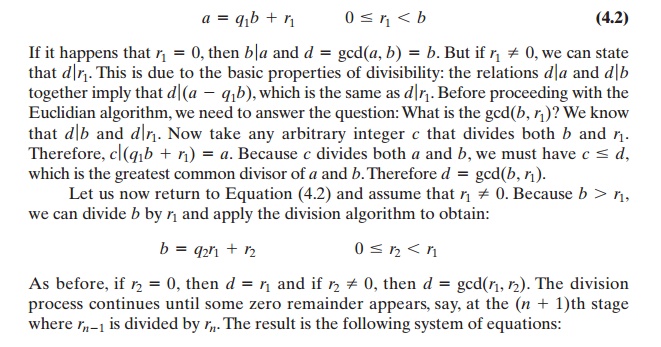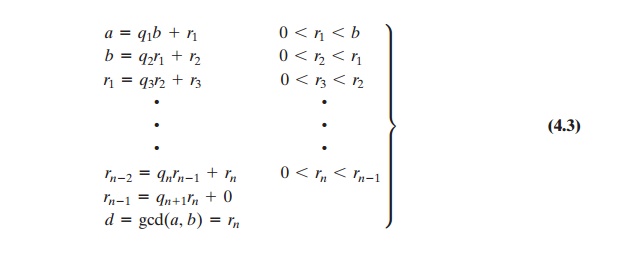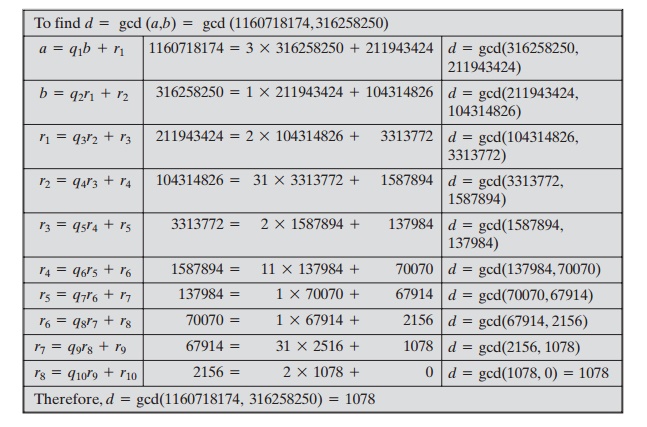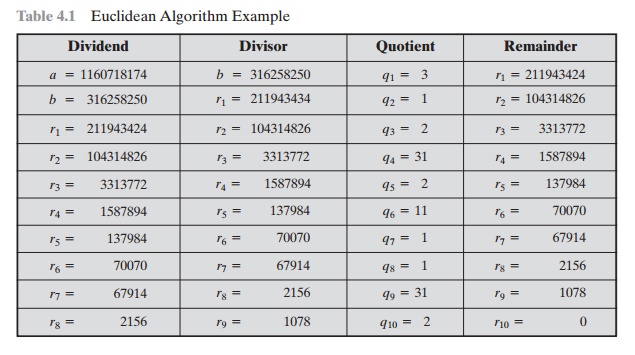Chapter: Cryptography and Network Security Principles and Practice : One Symmetric Ciphers : Basic Concepts in Number Theory and Finite Fields
The Euclidean Algorithm
THE EUCLIDEAN
ALGORITHM
One of the basic
techniques of number theory is
the Euclidean algorithm, which is a simple procedure for
determining the
greatest common divisor of two positive integers.
First, we need a simple definition: Two
integers are relatively prime if
their only common positive integer factor is 1.
Greatest Common Divisor
Recall that nonzero b is defined to
be a divisor of a if a = mb for some m,
where a,
b, and m are integers. We
will use the notation gcd(a,
b) to mean the greatest
common divisor of a and b. The greatest common divisor of a and b is the largest integer that divides both a and b. We also
define gcd(0, 0) = 0.
More formally, the
positive integer c is said to be the
greatest common divisor of a and b if
1.
c is
a divisor of a and
of b.
2.
Any divisor of a and b is a divisor of c. An equivalent definition is the following:
gcd(a,
b)
=
max[k, such that k | a and
k | b]
Because we require that the greatest common
divisor be positive, gcd(a, b) =
gcd(a, -b) = gcd( -a,
b)
= gcd( -a,-b). In general, gcd(a,
b)
= gcd( | a | , | b | ).
gcd(60, 24) = gcd(60,
-24) = 12
Also, because all nonzero integers divide 0, we have gcd(a, 0)
= | a | .
We stated that two integers a and b are relatively
prime if their only common positive integer factor is 1. This is equivalent to
saying that a and b are relatively prime if gcd(a, b) = 1.
8 and 15 are relatively prime because the positive divisors
of 8 are 1, 2, 4, and 8, and the
positive divisors of 15 are 1, 3, 5, and 15. So 1 is the only integer on both lists.
Finding the Greatest Common Divisor
We now describe an algorithm credited to
Euclid for easily finding the greatest common divisor of two integers. This
algorithm has significance subsequently in this chapter. Suppose we have
integers a, b such that d = gcd(a, b). Because gcd( | a | , | b | )
= gcd(a,
b), there is no harm in assuming a >= b > 0.
Now dividing a by
b and applying the division algorithm, we can state:



At each iteration, we have d = gcd(ri, ri + 1) until finally d = gcd(rn, 0) = rn. Thus, we can find the greatest common divisor of two
integers by repetitive application of the division algorithm. This scheme is
known as the Euclidean algorithm.
We have essentially argued from the top down that the final
result is the gcd(a, b). We can also argue from the bottom up. The first step
is to show that rn divides a and b. It follows from the
last division in
Equation (4.3)
that rn divides rn - 1. The next to last division shows that rn divides rn – 2 because it divides
both terms on the right. Successively, one sees that rn divides all ri’s and
finally a and b. It remains to show that rn is the largest divisor that divides
a and b. If we take any arbitrary integer that divides a and b, it must also
divide r1, as explained previously. We can follow the sequence of equations in
Equation (4.3) down and show that c must
divide all ri’s. Therefore c must divide rn, so that
rn = gcd(a, b).
Let us now look at an example
with relatively large
numbers to see the power of
this algorithm:

In this example,
we begin by dividing 1160718174 by 316258250, which gives 3 with
a remainder of 211943424. Next we take 316258250 and divide it by 211943424. The process continues until we get a remainder of 0, yielding a
result of 1078.
It will
be helpful
in what
follows to
recast the
above computation in tabular form. For every step of the iteration, we have ri - 2
= qiri - 1
+ ri, where ri - 2 is the dividend, ri - 1 is the divisor, qi is the quotient, and ri is the remainder. Table 4.1 summarizes the results.
Table
4.1 Euclidean Algorithm Example

Related Topics